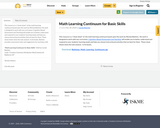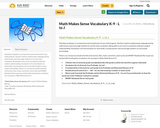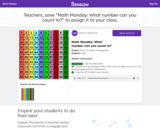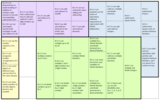
MSS LEAD Teacher Refresher Session iLearn 2022approx 1 hour
- Subject:
- Education
- Material Type:
- Assessment
- Author:
- Vanessa Lewis
- Date Added:
- 08/20/2021

MSS LEAD Teacher Refresher Session iLearn 2022approx 1 hour

«Ma France en classe:
You can download and print activities for the 24 units of Ma France. They involve the four main skills: Speaking, Reading, Listening and Writing.
Click on the appropriate picture to download the activity print-out.»
These units cover general life situations in French, set in France. Amusez-vous bien!
**Requires Javascript and a Flash plug-in**

Activities for students to complete after reading Macbeth to showcase their understanding of the play.

'Students have an opportunity to learn about their families in French. During the learning activities, students will become reacquainted with the “Soleil” family. '
*Instructions are in English.*
This is an extensive unit with a great deal of instructional material. The families represented are quite traditional (the resource is from 2001), but adaptations could be made to include a greater diversity of families and individuals.

This is an activity that compares the magnetic field of the Earth to the complex magnetic field of the Sun. Using images of the Earth and Sun that have magnets attached in appropriate orientations, learners will use a handheld magnetic field detector to observe the magnetic field of the Earth and compare it to that of the Sun, especially in sunspot areas. For each group of students, this activity requires use of a handheld magnetic field detector, such as a Magnaprobe or a similar device, a bar magnet, and ten small disc magnets.

This is an introductory course to computer science using micro:bits as the physical tool, and MakeCode as the language. The course covers basic computer programming commands like variables and loops. It also incorporates elements of design thinking, making and problem solving to work towards the completion of tasks and activities. The course takes about 4 weeks to complete with regular work, (1 week on lessons and 3 weeks on the final project). It is recommended for grades 6-8.

It can be challenging to navigate the many subtests that can be used in universal screening! Skilled reading involves the integration of many subskills. This chart can be used to identify the most pressing need for instruction. For older students – start at the top and work your way down to find the lowest barrier skill. For younger students learning to read (Kindergarten and grade 1), start at the bottom and work your way up to find the next skill to teach.
Early reading screening is an evidence-based way for educators and leaders to understand student and system risk. This document supports educators in understanding and making decisions about assessment and instruction.

"This chart can be used to identify the most pressing need for instruction. For older students - start at the top and work your way down to find the lowest barrier skill. For younger students learning to read (Kindergarten and grade 1), start at the bottom and work your way up to find the next skill to teach."

This is a lesson about the magnetic field of a bar magnet. The lesson begins with an introductory discussion with learners about magnetism to draw out any misconceptions that may be in their minds. Then, learners freely experiment with bar magnets and various materials, such as paper clips, rulers, copper or aluminum wire, and pencils, to discover that magnets attract metals containing iron, nickel, and/or cobalt but not most other materials. Next, learners experiment with using a magnetic compass to discover how it is affected by the magnet and then draw the magnetic field lines of the magnet by putting dots at the location of the compass arrow. This is the first lesson in the first session of the Exploring Magnetism teacher guide.

This is an activity about electromagnetism. Learners will use a compass to map the magnetic field lines surrounding a coil of wire that is connected to a battery. This activity requires a large coil or spool of wire, a source of electricity such as 3 D-cell batteries or an AC to DC power adapter, alligator-clipped wire, and magnetic compasses. This is the third lesson in the second session of the Exploring Magnetism teachers guide.

This is a lesson about using evidence to construct sequences of geologic events. Learners will interpret real NASA science data to identify features on the surface of Mars, determine the surface history of the area, calculate the size of features, and develope investigable questions. Students will study images taken by NASA's Mars Thermal Emission Imaging System (THEMIS) camera orbiting Mars. Students will use the THEMIS images to analyze the surface features and geological history of Mars. The lesson models scientific inquiry using the 5E instructional model and includes teacher notes and vocabulary.

This is an activity about image comparison. Learners will analyze and compare images taken by the Solar Dynamics Observatory. They will match four magnetic solar images, or magnetograms, to their corresponding extreme ultraviolet, or EUV, light images by studying solar features in the images. At the end, they will recognize that areas of high magnetic activity on the Sun correspond to extreme solar activity.

The purpose of this booklet is to cover the units on multiplying and dividing in grade 4 math.Included is ten topics with the step-by-step process of:Launch - Video for studentsTeacher TimeWork TimeTechnology TimeSelf-Assessment*adding extra practice sheets or assignments would be an optionThis resource was created by Shawna Moreside.

Basic Concepts of Math from The Greater Saskatoon Catholic Schools was created as a numeracy diagnostic to assess the Saskatchewan Math curriculum. This assessment provides a snapshot of student performance., and it is intended to give an indication of grade level outcome achievement in math. This information can be used to inform your instruction and help meet your students' needs. Sask DLC teachers proceed to section 2 for interim materials.

This resource is a "cheat sheet" of the math learning continuum based upon the work by Michael Battista. His work is designed to work with any curriculum, Cognition-Based Assessment and Teaching will enable you to better understand and respond to your students’ learning needs and help you choose instructional activities that are best for them. These cheat sheets show the task analysis. In his books, Battista provides assessment tasks and suggestions for teaching a skill.

Teaching vocabulary is an important and essential part of any math program. Teachers need to model proper language during math lessons and encourage students to use the same vocabulary. Being able to use correct vocabulary indicates student understanding. Vocabulary rich environments ex: word walls, concept posters also encourage student's to use proper terminology.
These L to J resources include all of the instructions, files, charts, word lists, word cards and SMART Notebook files to get you started with teaching the vocabulary rich concepts in Make Math Sense K-9.

Making partners of ten with a hands on Seesaw activity.

Remote Learning Math Assessment. What number can you count to?

The purpose of this booklet is to cover the unit on whole numbers to 10 000 in grade 4 math.Included is three topics with the step-by-step process of:Launch - Video for studentsTeacher TimeWork TimeTechnology TimeSelf-Assessment*adding extra practice sheets or assignments would be an optionThis resource was created by Shawna Moreside.

Math outcomes for grade 1-9 organized by grade and by topic. Each grade is a column so it is easy to work through a grade level. Horizontally and by colour or outline, the document is organized by topic so students and teachers can see the like outcomes within other grades. This document can help with future planning as well as with gap filling. It can also help teachers working in a Colony or multi-grade setting. I Can Statements are taken from Sun West 1-9 Outcome Tracking.